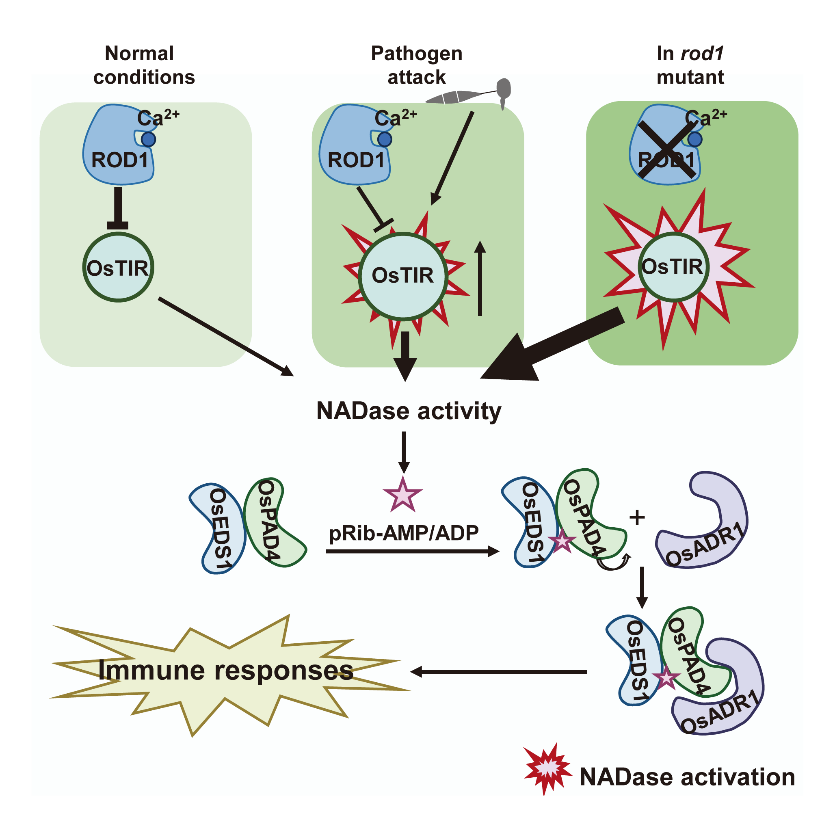Numerous pathogenic microorganisms threaten the entire life cycle of plants, leading to various diseases that result in significant losses in crop yields and quality. In China, a considerable amount of chemical pesticides are used annually to these diseases, exerting tremendous pressure on both the ecological environment and people's health. Cultivating disease-resistant varieties is an essential approach for green and sustainable control of crop diseases. Discovery of new resistance genes and in-depth studies on the mechanisms of plant immunity activation for broad-spectrum resistance against multiple pathogens provide an important theoretical foundation for breeding disease-resistant varieties.
After years of collaborative research, the teams led by Academician Zuhua He and Dr. Yu Zhang of CAS Center for Excellence in Molecular Plant Sciences (CEMPS) employed different research strategies, achieving a major breakthrough in understanding regulation of plant immunity. The related research findings were published online in the international authoritative academic journal Science on November 8, 2024. The study uncovered the molecular and biochemical functions of OsTIR, a TIR-only protein in cereals, revealing a signal network for fine regulation of plant immune homeostasis, and providing a new target for breeding crops resistant to multiple pathogens.
ROD1 was identified as a suppressor of plant immunity. Mutation in ROD1 causes cell death and reactive oxygen species (ROS) accumulation, resulting in autoimmune phenotype that significantly improves resistance to rice blast, bacterial blight, and sheath blight (Gao et al., Cell, 2021). However, the downstream pathways responsible for the enhanced immunity in rod1 remain unclear.
The research team conducted extensive genetic analysis of rod1 suppressors derived from large populations of EMS and γ-ray mutagenized rod1 seeds. Eighteen stable rod1 suppressors lines were obtained. Mapping and whole genome sequencing analysis revealed that OsEDS1, OsPAD4, OsADR1, and OsTIR function downstream of ROD1. OsTIR acts as an NAD+-cleaving enzyme to catalyze the production of small molecules pRib-AMP, triggering the formation of OsEDS1-OsPAD4-OsADR1 (EPA) immune complex to activate the immune response. ROD1 directly interacts with OsTIR and inhibits its NADase activity, thereby blocking the activation of EPA signaling pathway. Upon pathogens attack, ROD1 is degraded by E3 ubiquitin ligases, OsTIR is highly induced, leading to the activation of the EPA complex to enhance defense response. When ROD1 functions are impaired or absent, OsTIR activity is unleashed, resulting in the activation of the EPA complex and subsequent induction of autoimmunity. Thus, this study identified the molecular biochemical function of TIR-only protein OsTIR in rice for the first time, revealing a five-component immune network that coordinates immune homeostasis and dynamics, and provided a new target gene for disease resistance in crop breeding.
PhD students Yue Wu, Weiying Xu, Ziyao Lei, engineer Jiyun Liu from CEMPS, PhD student Guoyan Zhao from ShanghaiTech University, and PhD student Kui Li from Fudan University are Co-first authors of the research article. Academician Zuhua He, Dr. Yu Zhang, Dr. Yiwen Deng from CEMPS, and Dr. Mingjun Gao from Fudan University are co-corresponding authors. Additionally, Academician Jane E. Parker from Max Planck Institute of Molecular Plant Physiology in Germany and Professor Jijie Chai from Westlake University participated in the research of this work. This work was supported by National Natural Science Foundation of China, National Key Research and Development Program of China, Biological Breeding-National Science and Technology Major Projects, and Basic Research Zone Program of Shanghai.
Article link: https://doi.org/10.1126/science.adr2138

Fig1. Working model of immune control mediated by a important immune network ROD1-OsTIR-EPA

